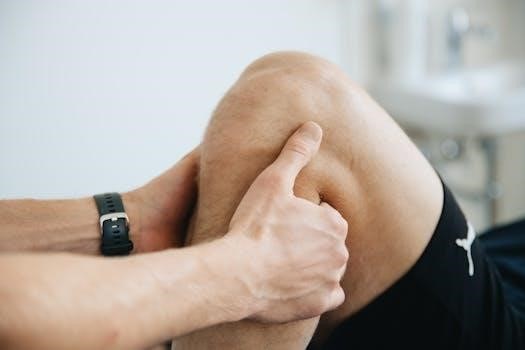Understanding SI Joint Dysfunction
The sacroiliac (SI) joint connects the spine and hip, playing a vital role in weight transfer and torso rotation. Dysfunction can lead to pain in the lower back and buttocks, sometimes radiating down the leg. Understanding its function helps in addressing related issues effectively.
What is the Sacroiliac (SI) Joint?
The SI joint, or sacroiliac joint, is a crucial structure located at the base of your spine where the sacrum and ilium bones of the pelvis meet. It’s one of the largest joints in the body, primarily functioning to transfer weight between your upper and lower body. This joint also facilitates torso rotation and assists in shock absorption during movement. The SI joint is stabilized by strong ligaments, which provide stability and allow for limited movement, essential for overall biomechanical function. It is important for daily activities and proper body function.
Causes of SI Joint Pain
SI joint pain can arise from various factors including previous injuries, surgeries, obesity, sedentary lifestyles, and poor posture. These elements can lead to dysfunction and discomfort in the sacroiliac joint.
Common Injuries and Conditions
Common causes of SI joint pain include injuries from falls or car accidents, which can directly impact the joint. Previous surgeries in the lower back or hip area can also contribute to dysfunction. Obesity increases stress on the joint, while a sedentary lifestyle can weaken supporting muscles. Poor posture can misalign the pelvis and SI joint, leading to discomfort. These factors can cause inflammation, pain, and restricted movement in the sacroiliac region, which needs proper attention and care.
Symptoms of SI Joint Issues
SI joint issues manifest through pain in the lower back or buttocks, often on one side. This pain might radiate down the leg. Increased discomfort with certain movements or prolonged sitting is also common.
Recognizing Pain and Discomfort
Recognizing SI joint pain involves noting its location, often in the lower back or buttocks, potentially on one side. The pain might feel like a dull ache or a sharp, shooting sensation. It can sometimes extend down the leg, mimicking sciatica. Certain activities, like prolonged sitting, specific movements, or standing for extended periods, can worsen the discomfort. Pay attention to any tightness or stiffness in the lower back and hip area, as these are indicators of possible SI joint dysfunction. Identifying these symptoms early is key for effective management.

The Role of Exercise in SI Joint Health
Exercise is crucial for managing SI joint pain by strengthening supporting muscles and improving flexibility. It promotes healthy movement patterns, reduces stress on the joint and helps alleviate discomfort.
Benefits of Strengthening and Stretching
Strengthening the muscles around the SI joint reduces injury risk by promoting healthy movement and relieving joint stress. Equal strengthening helps correct muscle imbalances. Stretching loosens tight muscles and improves flexibility, preventing imbalances that irritate the SI joint. Improved stability can be achieved through targeted exercises for the glutes, hips and thighs. These benefits can contribute to pain management and improved overall SI joint function. Exercise also helps warm up the muscles surrounding the SI joint, which may promote healing.

Essential Stretches for SI Joint Relief
Stretches are important for loosening tight muscles and improving flexibility in the back and hips. They may also prevent muscle imbalances that irritate the SI joints, thereby aiding in pain relief.
Examples of Effective Stretches
Several stretches can provide relief, including the sitting hip adductor stretch, where you sit with legs wide and lean forward. The quadriceps stretch involves standing, grabbing an ankle, and pulling towards the buttocks. The pigeon stretch, done on the floor, brings one ankle over the opposite knee. Other beneficial stretches include the couch hip flexor stretch, hip 90/90, child’s pose, and the spiderman stretch, each targeting different areas to improve flexibility and reduce tension around the SI joint.
Strengthening Exercises for SI Joint Stability
Strengthening exercises are crucial for SI joint stability, reducing injury risk and promoting healthy movement. These exercises often target core and hip muscles, correcting imbalances and relieving stress on the SI joint.
Examples of Core and Hip Strengthening Movements
Effective core and hip strengthening exercises for SI joint stability include dead bugs, which enhance core control and coordination. Kneeling planks are beneficial for improving core strength and stability without excessive lower back strain. Hollow holds engage deep core muscles, contributing to overall spinal stability. Additionally, supine bridges effectively target the glutes, hamstrings, and core, promoting balanced strength. Kneeling side planks enhance lateral core strength, crucial for SI joint support, while exercises like diaphragmatic breathing can also improve core stability by increasing intra-abdominal pressure.

Specific Exercises to Avoid with SI Joint Pain
Avoid exercises that involve arching or twisting the back, as these can exacerbate SI joint pain. Intense movements may also worsen symptoms; opt for low-impact options and gentle stretches instead. Listen to your body.
Movements That May Exacerbate Symptoms
Certain movements can increase stress on the SI joint, potentially worsening pain and discomfort. Activities involving excessive twisting of the torso, such as deep spinal twists, should be approached with caution or avoided. Exercises that require extreme arching of the back, like some yoga poses, can also place undue pressure on the joint. High-impact activities such as jumping or running may also be problematic for some individuals. It’s important to listen to your body and stop any movement that causes an increase in pain. When exercising, maintaining proper posture and engaging core muscles can provide stability and prevent over stressing the SI joint. Be mindful of your body’s response during exercise.
Creating a Consistent Exercise Routine
Establishing a regular exercise plan is key for managing SI joint pain. Consistency is more beneficial than intensity. Start slowly and gradually increase the duration and frequency of your chosen exercises.
Frequency and Intensity Guidelines
When starting an exercise routine for SI joint health, it’s crucial to begin with gentle movements. Aim for short, frequent sessions rather than long, intense ones. A few minutes of stretching and light strengthening multiple times a day can be more effective than infrequent, strenuous workouts. Pay close attention to your body’s signals and stop if you experience pain. Gradually increase the duration and repetitions as your strength and comfort improve. The key is to be consistent and avoid overexertion, which could exacerbate your symptoms.

The Importance of Professional Guidance
Seeking advice from a physical therapist or physician is essential for proper diagnosis and treatment of SI joint issues. They can provide personalized exercise plans and manual therapies.
When to Seek Physical Therapy
If you experience persistent lower back or buttock pain, especially if it radiates down your leg, seeking professional guidance is crucial. A physical therapist can accurately diagnose SI joint dysfunction and develop a tailored rehabilitation program. This program may include manual therapy, specific exercises, and education on proper body mechanics. They can help correct biomechanical faults, reduce pain, and improve long-term joint function. Ignoring pain can lead to chronic issues, so early intervention from a therapist will make a difference in your recovery and overall well-being.
Long-Term Management of SI Joint Pain
Managing SI joint pain long-term involves consistent lifestyle adjustments and regular exercise. Maintaining a healthy weight, practicing good posture, and continuing with prescribed exercises are all critical for sustained relief and joint health.
Lifestyle Adjustments and Exercise Maintenance
Long-term management of SI joint pain requires a commitment to lifestyle changes and consistent exercise routines; Maintaining a healthy weight reduces stress on the joint. Practicing good posture and avoiding prolonged sitting can alleviate discomfort. Regular low-impact activities like walking are beneficial, along with stretches and strengthening exercises. It’s crucial to stay active but also to listen to your body, avoiding movements that cause pain. Incorporating these habits helps prevent future flare-ups and promotes lasting joint health.
